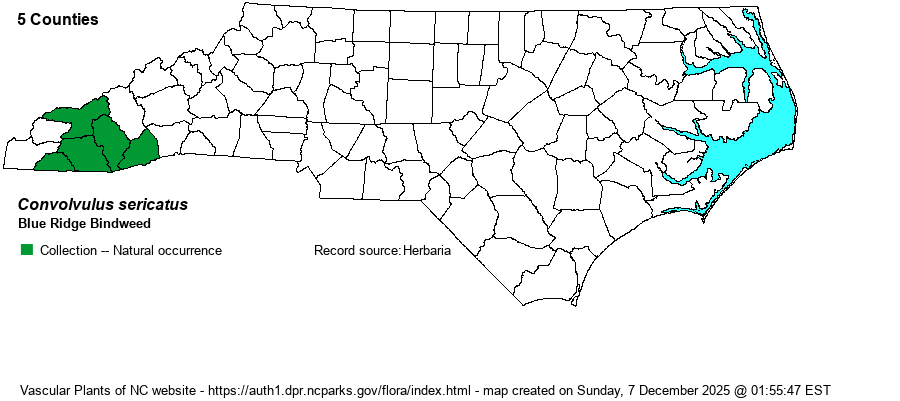| Author | House | |
| Distribution | Strictly in the southwestern Mountains, known from Clay, Macon, Jackson, Swain, and Transylvania counties. This was the primary part of the former Spithamaea sericata, but some records of that are now placed in Convolvulus catesbeianus; the remainder are now in this species, renamed as Convolvulus sericatus.
This is a narrow Southern Appalachian endemic, occurring only in southwestern NC, adjacent SC, and northern GA.
| |
| Abundance | Uncommon in its narrow range. It formerly was thought to be quite rare, but more detailed surveys have turned it up in enough places such that the NCNHP no longer tracks it as rare, nor even as a Watch List species. Because a part of the records formerly included in Calystegia sericata have been moved out of this species, the website editors feel that, in part owing to its small range, it should go back on the Watch List. The NCNHP did indeed place the newly defined species on the Watch List in late 2024. | |
| Habitat | This species grows on high pH soil of rich to mesic, forest edges, thickets, and openings. As with all vines, it favors places in partial to full sun. | |
| Phenology | Blooms in June and July, and fruits shortly after flowering. | |
| Identification | This is an herbaceous vine, growing to 2-3 feet on average, with alternate and ovate leaves with cordate bases -- like in others in the genus. It also has large white, funnel-shaped flowers to 2-3 inches long and wide, also as in other bindweeds. This species can be distinguished from the quite similar C. catesbeianus and C. purshianus by the leaves being "densely white-tomentose beneath" (Weakley 2024), versus leaves "pubescent or glabrous, but not densely white-tomentose beneath". | |
| Taxonomic Comments | See distribution. It is not clear what percentage of the records/specimens formerly within Calystegia sericata are still retained in Convolvulus sericatus, as opposed to moved to C. catesbeianus. The percentage moved out is probably low, but it should be remembered that this species is not completely comparable to the C. sericata as described in RAB (1968). Note that NatureServe no longer lists this taxon, or if so, it is not apparent what it might be.
| |
| Other Common Name(s) | None? | |
| State Rank | S2? | |
| Global Rank | G4T3 [G3] | |
| State Status | W1 | |
| US Status | | |
| USACE-agcp | | |
| USACE-emp | | |

